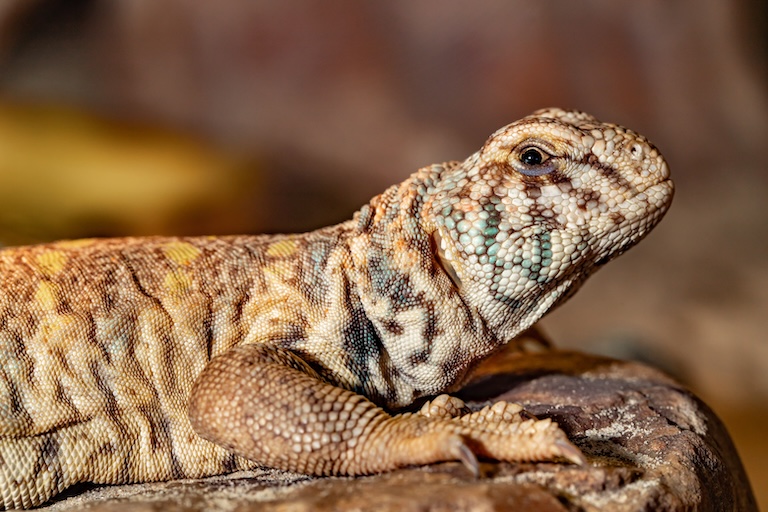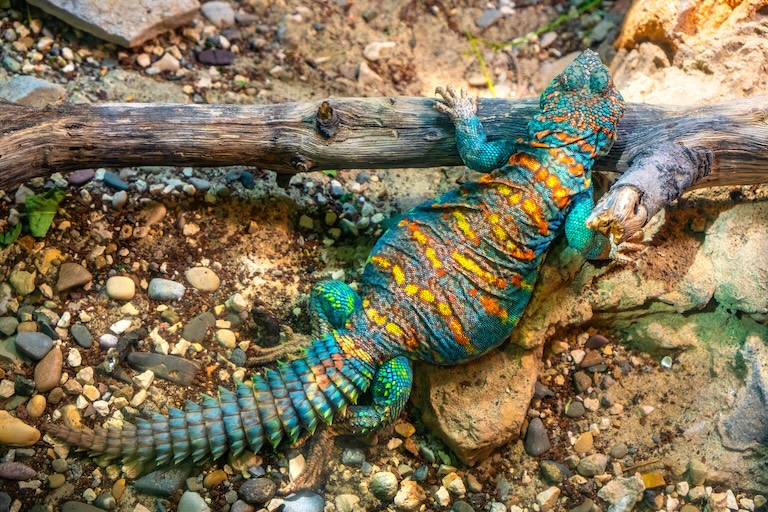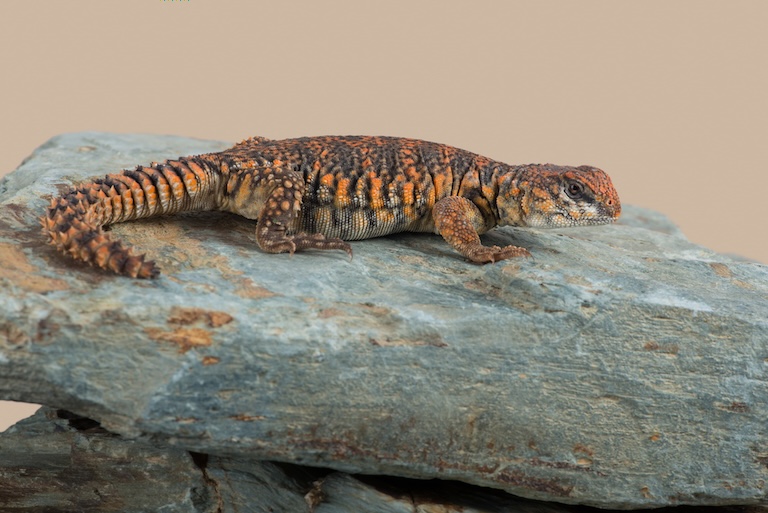Uromastyx Profile
Reptiles are known for being pretty confusing in their taxonomy, to the point where animals like the Komodo dragon may, in fact, turn out to be a sort of walking snake; slow worms, which are legless lizards; and New Zealand’s tuatara, which looks exactly like a lizard but is as far away from lizards as a tortoise is. And this is all before we even touch on birds!
So, when you’re pottering about in the desert and come across a reptile with the head of a turtle, the body of an iguana and the tail of a Pokémon, it’s a fair question to ask, “What the hell is that?”
But the answer is, most likely, a Uromastyx.

Uromastyx Facts Overview
| Habitat: | Dry, desert or savanna, rocky, gravel terrain |
| Location: | North Africa and the Middle East |
| Lifespan: | 15 to 40 years in captivity, some suggest possibly more than 60 |
| Size: | Up to 91 cm (36 in) long |
| Weight: | Up to 1.6 kg (3.5 lb) |
| Colour: | Varied |
| Diet: | Mostly vegetarian |
| Predators: | Raptors, small mammals, and snakes. Also Bedouin. |
| Top Speed: | Somewhere around 6 km/h |
| No. of Species: | 15 |
| Conservation Status: | Most are Least Concern, some Near Threatened and Vulnerable |
Uromastyx is actually a whole genus of lizards, related to, but quite unlike, the bearded dragons tattoo artists like to keep in their living rooms.
They come in some pretty impressive patterns, flavours and colours, are remarkably chill animals, and are pretty low maintenance for a reptile.
So, they make good pets, but the market for such animals has put strain on their wild populations, and so buyers should choose with care!
Interesting Uromastyx Facts
1. They’re agamids
The Uromastyx genus sits within the Agamidae family, and this is where we find the stunning, slender and amusingly head-bobbing Agamas. The 64 genera of Agamas in turn sit within the suborder of Iguania, which contains chameleons and iguanas, and this rank, despite containing around 2,000 species, is about a fifth of the size of the remainder of the Squamata order.
So, lizards are already weird and wonderful, and in most modern cladistics, this group sits closer to snakes than geckos, which highlights how convoluted the order is.
But back to the genus, Uromastyx are basically a fatter, slower, turtle-headed desert burrowing version of the Agamas. And while they do look distinct, many bring over some of the incredible colouration of their cousins.

2. They can change colour
In the wild, Uromastyx are typically duller browns, greys, and oranges, but there are some corkers too, like the ocellated Uromastyx, which sports bright blue areas of skin with yellow and orange spots down their backs.
Like the Agamas, the males are typically brighter in colour than the females, but in contrast to Agamas, in Uromastyx, the females can be larger.
These are pretty big lizards, too. The ocellated reaches around 30 cm or a foot long, but the largest can push up against a metre in length. This makes them a meaty beast, especially valuable as a food source in their barren and low-production habitats.
So, historically, they have been eaten. 1
3. They’re edible
The Bedouin are perhaps the closest we can get to an ancient alien race within our own species. These are the real-life Tusken raiders or Fremen, originating in the Syrian desert and incorporating literal raids on other tribes into their cultural traditions.
And, like the caravan people in the wastelands of Fallout, they would make use of Iguana on a stick for a handy protein source. This traditional dish was known as “dabb” and was once considered an Arabian delicacy. 2
4. They’re docile
But if you’re not interested in eating one, you can still spend time with them. Uromastyx are not aggressive at all, and being so chunky, they are not very good at escaping when you chase them, so they’re easy to catch, not likely to bite and will mostly just keep still and wait for you to let them go.
This lack of aggression is one of the many factors that have led to this genus being very popular as pets.
5. They make decent “pets”
Reptiles tend to stretch the definition of pet towards something that is typically more like a breathing, high-maintenance ornament, but there are some exceptions.
The low energy of the metabolism of lizards in general extends to their brains and personalities, and so these are damper animals than, say, even a hamster might be, but they do have both brains and personalities to observe if you spend enough time with them.
Uromastyx lizards have colour, decent size, and a distinct lack of danger to their credit as companions in the home. They don’t eat meat, so they’re not even a threat to the local insect fauna, and they are large, meaning they can maintain their body temperature outside of their heat mats for longer than a smaller reptile might.
This also makes them harder to lose, since they don’t fit neatly between the fins of a radiator like a snake, nor can they run up the walls like a gecko.
So, all in all, they’re a low-maintenance pet for a reptile, and they’re pretty popular for their colouration, too, which has been selected for in domestic lines to accentuate it.
Unfortunately, this popularity has put a strain on wild populations.
6. But they shouldn’t be taken from the wild
In Morocco, for example, not only are these lizards taken from the wild for pets, they’re also part of a rising trade in alternative medicinal products for people so special that modern medicine doesn’t work on them, and instead must rely on imagination.
Uromastyx are collected and sold in Pakistan to people all over the world, sometimes even on YouTube. So, the decline in many of the species of the genus can be attributed not only to the pet trade but to the same unfounded idiocy as the decline in rhinos.
And this is particularly silly, considering that these animals readily breed in captivity with just a little consideration.
This shouldn’t need spelling out, but: regardless of how many you eat, no genus of wild lizard is capable of curing anything, let alone stupid, nor will they in any way compensate for the lacklustre quality of your genitals. 3

Uromastyx Fact-File Summary
Scientific Classification
| Kingdom: | Animalia |
| Phylum: | Chordata |
| Class: | Reptilia |
| Order: | Squamata |
| Family: | Agamidae |
| Genus: | Uromastyx |
| Species Name: | 15 species |
Fact Sources & References
- r/reptiles, “Same lizard, different colors. Uromastyx never cease to amaze me!”, Reddit.
- Omar Usman (2008), “Sunnah of the Dhab Lizard Delicacy”, Muslim Matters.
- Gondhali et al. (2023), “Hidden in plain sight: Investigating the illegal trade of medical products derived from the spiny-tailed lizard (Uromastyx spp.) through the surface web”, Science Direct.
